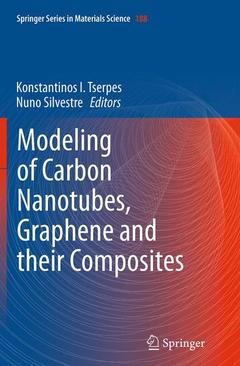Description
Modeling of Carbon Nanotubes, Graphene and their Composites, 2014
Springer Series in Materials Science Series, Vol. 188
Coordinators: Tserpes Konstantinos I., Silvestre Nuno
Language: English
Subjects for Modeling of Carbon Nanotubes, Graphene and their Composites:
Publication date: 08-2016
Support: Print on demand
Publication date: 10-2013
332 p. · 15.5x23.5 cm · Hardback
Description
/li>Contents
/li>Biography
/li>Comment
/li>
Konstantinos I. Tserpes is a Mechanical Engineer with a Ph.D. in Strength Prediction of Composite Materials. Currently, he is a Lecturer of Strength of Materials at the Department of Mechanical Engineering & Aeronautics, University of Patras, Greece. His research interests are in the areas of Strength of Composite Materials, Strength of Bonded and Bolted Joints, Mechanical Behavior of Carbon Nanotubes, Graphene and Nano-Reinforced Composites, Multi-scale Analysis of Materials and Structural Parts, Development of Methodologies for Relating Data from Non-destructive Testing with Numerical Strength Prediction Models as well as Strength Prediction of Corroded Aluminum Parts. He has published 1 chapter in a book, more than 30 papers in journals and more than 40 papers in Conference proceedings. He has 14 years of research experience in the area of aeronautical structures gathered through participation in national and international research projects.
Nuno Silvestre is Associate Professor at the Department of Mechanical Engineering of IST – University of Lisbon, Portugal. He holds a PhD degree in Civil Engineering and has more than 20 years of experience in teaching, researching and consulting. His research interests include Nanomechanics, Simulation at Nanoscale, Behaviour of Thin-walled Structures, Nonlinear Solid Mechanics and Numerical Analysis of Structures, Structural Stability and Dynamics, and Design of Steel and FRP Composite Structures. He has more than 70 journal publications in peer reviewed journals and about 200 communications in international conferences. Professor Silvestre participated in several funded R&D projects, supervised several PhD and MSc students and received many awards from international and national institutions in recognition for his scientific achievements. He is also an esteemed member of several scientific and management committees, member of 7 editorial boards of international journals, and also areferee to




